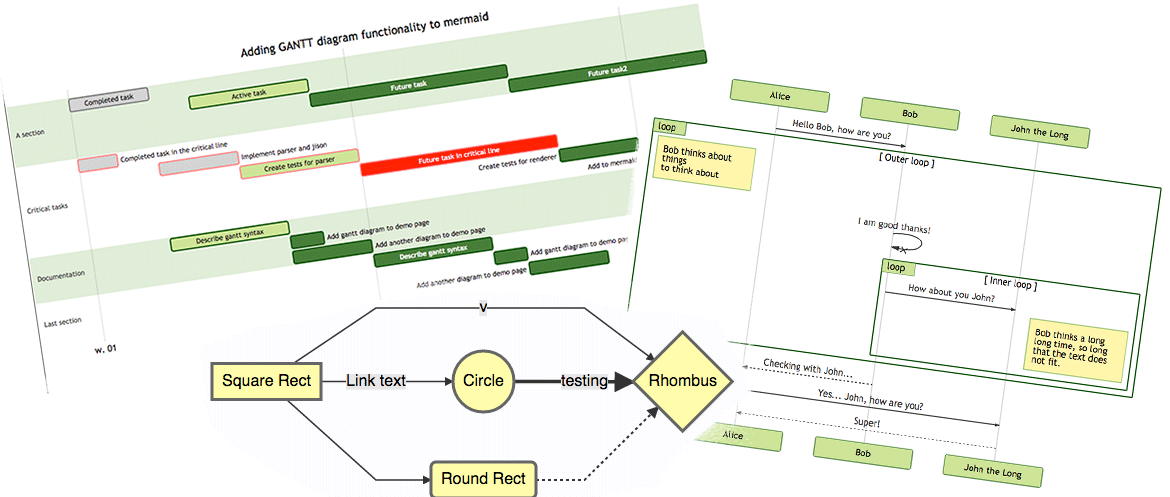Warning
This article was last updated on 2022-07-23, the content may be out of date.

The mermaid shortcode supports diagrams in Hugo with Mermaid library.
Mermaid is a library helping you to generate diagram and flowcharts from text, in a similar manner as Markdown.
Just insert your mermaid code in the mermaid shortcode and that’s it.
Tip
You can configure mermaid themes globally in config.toml via the params.mermaid parameter
Flowchart
Example flowchart mermaid input:
1
2
3
4
5
6
7
|
{{< mermaid >}}
graph LR;
A[Hard edge] -->|Link text| B(Round edge)
B --> C{Decision}
C -->|One| D[Result one]
C -->|Two| E[Result two]
{{< /mermaid >}}
|
The rendered output looks like this:
Sequence Diagram
Example sequence diagram mermaid input:
1
2
3
4
5
6
7
8
9
10
11
12
13
|
{{< mermaid >}}
sequenceDiagram
participant Alice
participant Bob
Alice->>John: Hello John, how are you?
loop Healthcheck
John->John: Fight against hypochondria
end
Note right of John: Rational thoughts <br/>prevail...
John-->Alice: Great!
John->Bob: How about you?
Bob-->John: Jolly good!
{{< /mermaid >}}
|
The rendered output looks like this:
Gantt
Example Gantt mermaid input:
1
2
3
4
5
6
7
8
9
10
11
12
|
{{< mermaid >}}
gantt
dateFormat YYYY-MM-DD
title Adding GANTT diagram to mermaid
excludes weekdays 2014-01-10
section A section
Completed task :done, des1, 2014-01-06,2014-01-08
Active task :active, des2, 2014-01-09, 3d
Future task : des3, after des2, 5d
Future task2 : des4, after des3, 5d
{{< /mermaid >}}
|
The rendered output looks like this:
Class Diagram
Example class diagram mermaid input:
1
2
3
4
5
6
7
8
9
10
11
12
13
14
15
16
17
18
19
20
21
22
23
|
{{< mermaid >}}
classDiagram
Animal <|-- Duck
Animal <|-- Fish
Animal <|-- Zebra
Animal : +int age
Animal : +String gender
Animal: +isMammal()
Animal: +mate()
class Duck{
+String beakColor
+swim()
+quack()
}
class Fish{
-int sizeInFeet
-canEat()
}
class Zebra{
+bool is_wild
+run()
}
{{< /mermaid >}}
|
The rendered output looks like this:
State Diagram
Example state diagram mermaid input:
1
2
3
4
5
6
7
8
9
|
{{< mermaid >}}
stateDiagram-v2
[*] --> Still
Still --> [*]
Still --> Moving
Moving --> Still
Moving --> Crash
Crash --> [*]
{{< /mermaid >}}
|
The rendered output looks like this:
Git Graph
Example git graph mermaid input:
1
2
3
4
5
6
7
8
9
10
11
12
13
|
{{< mermaid >}}
gitGraph
commit
commit
branch develop
checkout develop
commit
commit
checkout main
merge develop
commit
commit
{{< /mermaid >}}
|
The rendered output looks like this:
Entity Relationship Diagram
Example entity-relationship diagram mermaid input:
1
2
3
4
5
6
|
{{< mermaid >}}
erDiagram
CUSTOMER ||--o{ ORDER : places
ORDER ||--|{ LINE-ITEM : contains
CUSTOMER }|..|{ DELIVERY-ADDRESS : uses
{{< /mermaid >}}
|
The rendered output looks like this:
User Journey
Example user journey mermaid input:
1
2
3
4
5
6
7
8
9
10
11
|
{{< mermaid >}}
journey
title My working day
section Go to work
Make tea: 5: Me
Go upstairs: 3: Me
Do work: 1: Me, Cat
section Go home
Go downstairs: 5: Me
Sit down: 5: Me
{{< /mermaid >}}
|
The rendered output looks like this:
Pie Chart
Example pie chart mermaid input:
1
2
3
4
5
6
|
{{< mermaid >}}
pie
"Dogs" : 386
"Cats" : 85
"Rats" : 15
{{< /mermaid >}}
|
The rendered output looks like this:
Requirement Diagram
Example requirement diagram mermaid input:
1
2
3
4
5
6
7
8
9
10
11
12
13
14
15
16
|
{{< mermaid >}}
requirementDiagram
requirement test_req {
id: 1
text: the test text.
risk: high
verifymethod: test
}
element test_entity {
type: simulation
}
test_entity - satisfies -> test_req
{{< /mermaid >}}
|
The rendered output looks like this:
